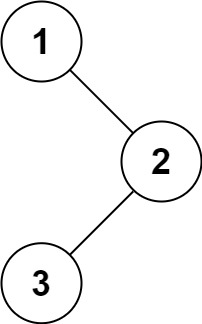Given the root of a binary tree, return the inorder traversal of its nodes’ values.
Example 1:

1
2
| Input: root = [1,null,2,3]
Output: [1,3,2]
|
Example 2:
1
2
| Input: root = []
Output: []
|
Example 3:
1
2
| Input: root = [1]
Output: [1]
|
Example 4:

1
2
| Input: root = [1,2]
Output: [2,1]
|
Example 5:

1
2
| Input: root = [1,null,2]
Output: [1,2]
|
Constraints:
- The number of nodes in the tree is in the range
[0, 100].
-100 <= Node.val <= 100
Follow up:
Recursive solution is trivial, could you do it iteratively?
1 递归
记得之前看到过这个非递归解法, 但是实在想不出来了😭😭
1
2
3
4
5
6
7
8
9
10
11
12
13
14
15
16
17
18
19
20
21
22
23
24
25
26
27
28
29
30
31
32
33
|
class Solution {
public List<Integer> inorderTraversal(TreeNode root) {
List<Integer> ans = new ArrayList<>();
inorderTraversal(ans, root);
return ans;
}
private void inorderTraversal(List<Integer> ans, TreeNode root)
{
if(root == null)
return;
else
{
inorderTraversal(ans, root.left);
ans.add(root.val);
inorderTraversal(ans, root.right);
}
}
}
|
2 非递归
具体方法还是看代码吧. 感觉很难描述.
当初看解析的时候也看了半天才懂
1
2
3
4
5
6
7
8
9
10
11
12
13
14
15
16
17
18
19
20
21
22
23
24
25
26
27
28
29
30
31
32
33
34
35
|
class Solution {
public List<Integer> inorderTraversal(TreeNode root) {
Stack<TreeNode> stk = new Stack<>();
List<Integer> inorder = new ArrayList<>();
TreeNode p = root;
while(p != null || !stk.isEmpty())
{
while(p != null)
{
stk.push(p);
p = p.left;
}
p = stk.pop();
inorder.add(p.val);
p = p.right;
}
return inorder;
}
}
|


